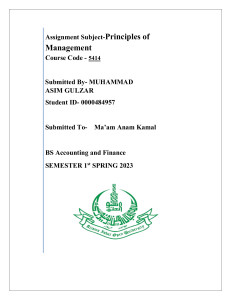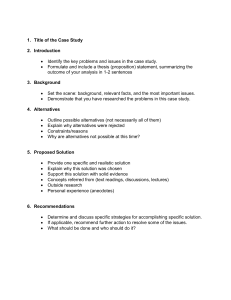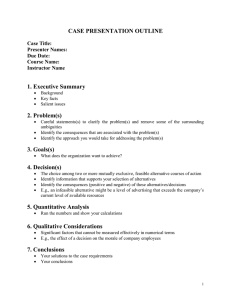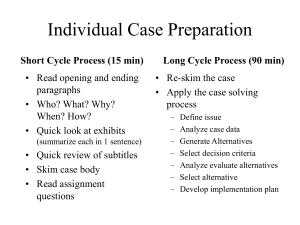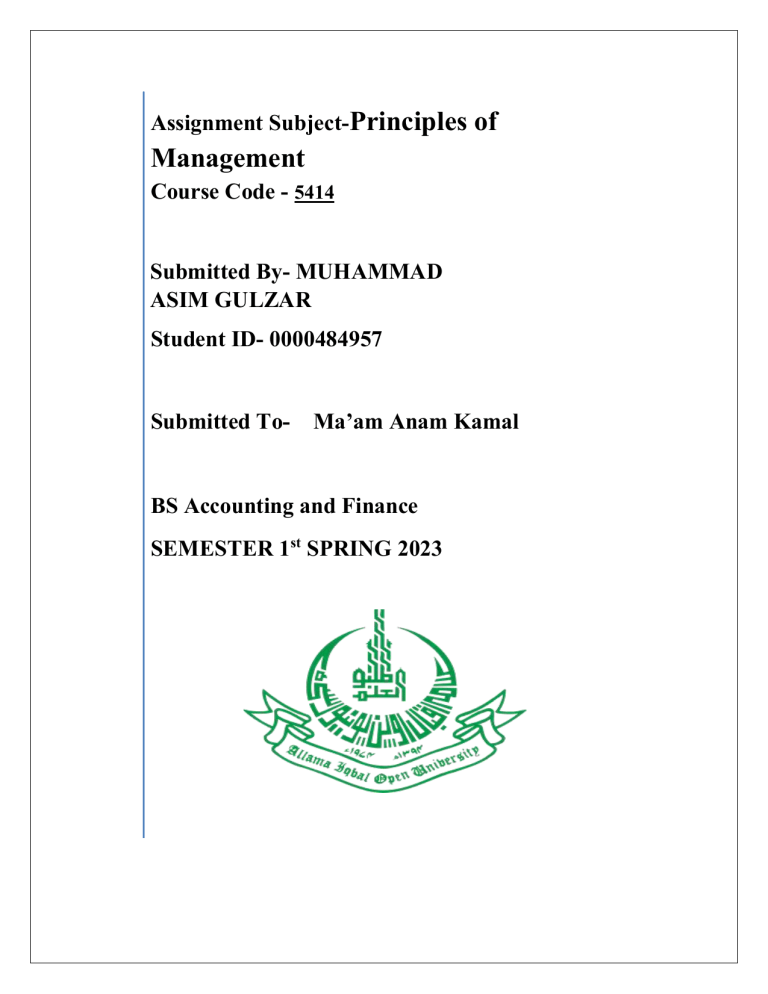
Assignment Subject-Principles of Management Course Code - 5414 Submitted By- MUHAMMAD ASIM GULZAR Student ID- 0000484957 Submitted To- Ma’am Anam Kamal BS Accounting and Finance SEMESTER 1st SPRING 2023 Principles of Management 5414 Principles of Management Question No (1) Define Management & Describe its Functions: Introduction to Management: Frederick Taylor, A century ago defined a concept called management as "knowing exactly what you want (people) to do and doing in best and cheapest way". This is the simplest definition of management. With the passage of time, this concept accommodated many complexities and challenges which broaden its scope. With all inherent complexities and challenges management is defined as a process of integrating and coordinating the activities toachieve goal efficiently and effectively. Let's have a look on key components of definition. A process: Process is a set of activities linked together to achieve the goal. Management as a process not only integrates the activities but it also sequences the activities and establishes coordination to achieve the goal. Continuity is also the essence of a process. It means management is continuous exercise. An organization does to achieve the set targets. Efficiently: This term refers to the best use of resources and "best use" means minimum wastage of resources to get maximum output. For example, right person on right job and in right number. Effectiveness: Every organization or a business is working to achieve a certain target or goal. Attainment of the set target or goal through doing right things is effectiveness. Management Functions: During early twentieth century, Henry Fayol proposed five functions of management including planning, organizing, commanding, communication and controlling now these functions are condensed to four: 1|Page Principles of Management 1. Planning 2. Organizing 3. Leading 4. Controlling Planning: Planning is very important pillar of a business. It involves setting of a goal and establish plan to accomplish that goal. Goal setting is the initial step to start a business and it gives a clear direction to follow. How to achieve that goal, is about devising strategies and mapping activities necessary to achieve that goal. Organizing: Organizing is the process of arranging and allocating resources to implement the plans to achieve the goal. This function includes number of activities such as defining tasks needed to be done, prioritization of activities, roles of key players (employee), combining tasks to define a job, grouping departments together, allocation and division of resources. Best organization of activities, departments, resources, and procedures will increase the success of a business. Leading: Every organization is the collection of people who together to reach the goal. Leading is the process to influence the behavior of people to get the work done. it involves energizing people at work through motivation, providing them best working environment and inspire them to achieve organization's goal. Controlling: Once an organization set a goal and devise plan (Planning), Organize resources (Organizing), Engage and motivate People (Leading), then it needs to assess the performance to ensure that we achieved what we want to achieve (goal). Controlling is the process of monitoring activities and measuring performance to compare it with the set targets. It is a continuous process, management at firm keep on monitoring the activities from start to end and take corrective actions to achieve expected results towards goal. These all functions are interconnected. For example, control function will tell you whether plans and activities are working in right direction or not. IF plans are failed to achieve the goal, they should be reconsidered. Similarly, leading function helps to engage and keep people motivated to give their best to organization. These functions are performed at different managerial levelsbut the Question is who will perform these functions? 2|Page Principles of Management Question No (2) Explain The Concepts of Certainty, Risk and Uncertainty for Decision Making: There are three different conditions managers face while doing decision, 1. Risk 2. Uncertainly 3. Certainty Certainty: One of the ideal situations of making decision. The outcome of every alternative is known, so managers can make decisions very smartly and accurately. For instance, information regarding interest rate which each bank is offering and the Earning on the funds is important to make decision to take loan from bank. It is certainty. Risk: The state of decision making in which the decision maker can estimate the chances of the outcomes of certainty. Managers have data from past experiences or secondary data. For instance, a resort manager wants to add another lift, he has the past data of last 10 years i.e. one year of light snow fall, 4 years of heavy, and 5 years of normal snow fall along having the data revenue generated each year. We can use this dada by calculating expected value of each year. Event Expected revenue Probability Heavy snow fall Normal snow fall $800,000 $710,000 0.4 0.5 Light snow fall Total $325,000 0.1 3|Page Expected value of each alternative $320,000 355,000 35,200 710,200 Principles of Management Uncertainty: In some of the situations we are not certain about the outcomes of the alternatives. Such situations are known as uncertainty. In the situation mentioned above the managers need to take the decision on the basis of the given data and on psychological orientation. 4|Page Principles of Management Question No (3). What do you mean By Planning and Discuss the process of planning in a business Organization? Planning: Planning is the process by which managers establish goals and define the methods by which these goals are to be attained. Planning involves selecting missions and objectives and the actions to achieve them; it requires decision making, which is choosing from among alternative future courses of action. “Planning is deciding in advance what is to be done; that is a plane is a projected course of action.” Planning Process: 1. 2. 3. 4. 5. 6. 7. 8. Recognizing Need for Action Setting Objectives Developing Premises Identifying Alternatives Examining Alternative Course of Action Selecting the Alternative Formulating Supporting Plan Implementation of the Plan 1) Recognizing Need for Actions: An important part of the planning process is to be aware of the business opportunities in the firm’s external environment as well as within the firm. Once such opportunities get recognized the managers can recognize the actions that need to be taken to realize them. A realistic look must be taken at the prospect of these new opportunities and SWOT analysis should be done. 2) Setting Objectives: This is the second and perhaps the most important step of the planning process. Here we establish the objectives for the whole organization and also individual departments. Organizational objectives provide a general direction, objectives of departments will be more planned and detailed. 5|Page Principles of Management Objectives can be long term and short term as well. They indicate the end result the company wishes to achieve. So, objectives will percolate down from the managers and will also guide and push the employees in the correct direction. 3) Developing Premises: Planning is always done keeping the future in mind however, the future is always uncertain. So, in the function of management certain assumptions will have to be made. These assumptions are the premises. Such assumptions are made in the form of forecasts, existing plans, past policies etc. These planning premises are also of two types- internal and external. External assumptions deal with factors such as political environment, social environment, the advancement of technology, competition, government policies, etc. Internal assumptions deal with policies, availability of resources, quality of management etc. These assumptions being made should be uniform across the organization. All managers should be aware of these premises and should agree with them. 4) Identifying Alternatives: The fourth step of the planning process is to identify the alternatives available to the managers. There is no one way to achieve the objectives of the firm. There is a multitude of choices. All of these alternative courses should be identified. There must be options available to the manager. Maybe he chooses an innovative alternative hoping for more efficient results. If he does not want to experiment, he will stick to the more routine course of action. The problem with this step is not finding the alternatives but narrowing them down to a reasonable number of choices so all of them can be thoroughly evaluated. 5) Examining Alternate Course of Action: The next step of the planning process is to evaluate and closely examine each of the alternative plans. Every option will go through an examination where all their pros and cons will be weighed. The alternative plans need to be evaluated in light of the organization objectives. For example, if it is a financial plan. Then it that Case its risk-return evaluation will be done. Detailed calculation and analysis are done to ensure that then plan is capable of achieving the objectives in the best and most efficient manner possible. 6|Page Principles of Management 6) Selecting the Alternative: Finally, we reach the decision-making stage of the planning process. Now the best and most feasible plan will be chosen to be implemented. The ideal plan is the most profitable one with the least number of negative consequences and is also adaptable to dynamic situations. The choice is obviously based on scientific analysis and mathematical equations. But Managers intuition and experience should also play a big part in this decision. Sometimes a few different aspects of different plans are combined to come up with the one ideal plan. 7) Formulating Supporting Plan: Once you have chosen the plan to be implemented, managers will have to come up with one or more supporting plans. These secondary plans help with the implementation of the main plan. For example, plans to hire more people, train personnel, expand the office etc are supporting plans for the main plan of launching a new product. So, all these secondary plans are in fact part of the main plan. 8) Implementation of the Plan: Finally, we come to the last step of the planning process, implementation of the plan. This is when all the other functions of management come into play and the pan is put into action to achieve the objectives of the organization. The tolls required for such implementation involve the type of plans- procedures, policies, budgets, rules, standards etc. 7|Page Principles of Management Question No (4) Define Decision Making and Discuss its Process In our everyday life we make choices, what to study, what career to pick, which country to go. Managers intheir professional life make many decisions. Decisions they make range from daily operations to long term. Therefore, some decisions are quickly made whereas long-term decision-making process involves multiple critical steps. Let’s discuss the decision-making process in detail. Decision Making Process: Managers at different managerial levels make different decisions range from day to day to long term. They make choices and choose the best from available options. Top managers investigate the market and identify customer’s needs, wants and competitors’ actions so that they can take decisions accordingly. But making decisions is not just an easy take as it looks, everybody at different levels in the organization have to take decisions according to their designation. Research recommends that to become an efficient manager in decision making, follow the concept mentioned in the decision-making process.Although practicing these steps will not always result into desired outcomes, because every stage is critical and require the correct inputs. Let us try to understand with the example of a manager Mr. Mzmil, he has to decide which laptops should be purchased for his sales team. Step 1: Identification of A Problem: In the modern era with speedy advancement and up gradation in technology, Mr. Mzmil identifies that the old Technology based laptop is very slow and are not efficient in multi-tasking which ultimately is affecting online sale process. Here the problem originates. How does a manager find the problem? Most of the time the problem is not so clear like the flashing signal light. In this case, Mr. Mzmil’s sales representative started complaining about their computers, which was an alarming situation and needs to be addressed. Very few problems are very much obvious therefore, managers must be vigilant in keeping the difference between the problem and the symptoms of the problem. In the above examples, online sales are the symptoms of the problem. Is a few percentages drop a problem? Or reduce in the sales percentage is the symptom of the actual problem, such as marketing, poor quality product or high prices. Keeping in mind the main subject is to identify the real problem here. Step 2: Identifying Decision Criteria: 8|Page Principles of Management Once the manager has found the problem, the next step is to figure out the decision criteria to solve the problem. Being a decision maker, criteria guide to make clear decisions. In the example mentioned above the Mr. Mzmil has set the following criteria to make a quick decision such as battery, warranty, weight, cost screen size and reliability. Step 3; Allocation of Weights to the Criteria: If the Criteria set by manager is not equally important, then he or she must give weights to the criterion indicators based upon the priority and importance,but how? The simplest way is to give the weightage of 10 to the most important criterion and the weights to the rest based upon the standard. Obviously, you can use any number to the highest weight. 1. Identification of a problem Sale team need update Laptops 2. Identifying decision criteria Cost Battery Storage Warranties Screen Size Warranties Reliability 3. Allocation of weights to criteria Reliability…..........10 Battery Storage…08 Warranties……..…05 Weight……………..05 Cost………………….04 9|Page Principles of Management Screen Size……...03 4. Development of alternatives Acer, Hp, Sony, Toshiba, Dell, Lenovo 5. Analyzing alternatives Acer, Hp, Sony, Toshiba, Dell, Lenovo 6. Selection of Alternatives Acer, HP, Sony, Toshiba, Dell, Lenovo 7. Implementation of alternative Hp Inspiration 8. Evaluating decision effectiveness Step 4: Development of Alternatives: The fourth step is to identify or create all possible alternatives require to solve the problem. In this step the job is to list the alternatives not to evaluate. Our sales manager Mr. Mzamil has created all the possible choices as shown in the exhibit below such as Acer, Compaq, Sony, Toshiba, HP and Dell. 10 | P a g e Principles of Management Step 5: Analyzing the Alternatives: Once the alternatives have been identified by the decision maker, next step is to analyze them but how? The answer is “criteria” made in Step 2. Manager Mzmil has assigned values after doing research on the given alternatives as shown in exhibit 4.2. Different Criterion is used to analyze the available alternatives. Values assigned inn this step will be multiplied to each alternative with the weight given in next step to get weighted alternatives as shown in the exhibit 4.4 Choices Memory Storage 6 4 10 8 7 10 Acer Compaq HP Sony Toshiba Dell Exhibit 4.1 & Battery Reliability 7 8 10 6 8 10 Warranty Weight Cost 8 7 8 10 7 6 8 9 10 6 8 10 7 8 6 5 8 10 Screen Size 9 7 9 9 5 7 Step 6: Selection of an Alternative: The sixth step in decision-making process is selecting the best alternative in all Aspects look in exhibit 4.2, the alternative with highest score is HP and Dell. Mr. Mzmil has to choose either HP or Dell because both has scored (321) highest among other alternatives. Choices Reliability Acer 56 Compaq 64 HP 80 Sony 48 Toshiba 64 Dell 80 Exhibit 4.2 Memory and Battery Storage 60 40 100 82 70 100 Warranty Weight Cost 64 35 40 50 35 30 40 45 50 30 40 50 28 32 24 20 32 40 Screen Size 27 21 27 27 15 21 total 275 237 321 255 256 321 Step 7: Implementation of the Alternative: In this step, we have to implement the selected alternative or need to put decision in action to resolve the identified problem. It is effective to involve the person who supposed to implement the decision for timely and quick results. 11 | P a g e Principles of Management Step 8: Evaluation of Decision Effectiveness: The last step of this process is to evaluate the results of the decision to find whether the problem is solved or not. If the problem is fixed its good, and if not then manager needs to check where it went wrong. Was the problem not properly defined? We errors occurred, while implementing the decision. Answers will lead you towards the proper way or might be to follow the process again. 12 | P a g e Principles of Management Question No (5) Define Planning How Does “Informal Planning”differ from “Formal Planning” Without planning, an organization is driven by every single change in its environment. This is not good for the success of any business. Organizations are planning by keeping in view the future forecasts of different mega environmental factors. Planning Is one of the key functions of management that sets goal for the organization. It involves multi-stage process. Planning is the process by which managers establish goals and define the methods by which these goals are to be attained. Planning involves selecting missions and objectives and the actions them; if requires decision making, which is choosing from among alternative future courses of action. “Planning is deciding in advance what is to be done; that is a plan is a projected course of action. Planning refers to the process of setting goals, identifying the steps required to achieve those goals, allocating resources, and creating a timeline for their completion. It involves foreseeing potential obstacles, making decisions, and organizing efforts to accomplish desired outcomes efficiently. Formal & Informal Planning differ in several key aspects: 1. 2. 3. 4. 5. 6. 7. Structure and documentation Flexibility vs. rigidity Scope and complexity Communication and Collaboration Accountability and Monitoring Risk Management Long-Term vs. Short-Term 13 | P a g e Principles of Management 1. Structure and Documentation: Informal Planning: It lacks strict structure and detailed documentation. Plans are often in the form of mental notes, discussions, or informal conversations. Formal Planning: It follows a structured approach with well-defined steps, documented goals, action items, timelines, responsibilities, and resource allocations. Plans are usually written down and easily accessible. 2. Flexibility vs. Rigidity: Informal Planning: It is more flexible and adaptable to changing circumstances. Decisions can be made on the spot based on personal judgment and immediate needs. Formal Planning: It tends to be more rigid due to the predefined structure. Changes often require formal revision of the plan, which can be time-consuming. 3. Scope and Complexity: Informal Planning: Suited for smaller projects, simple tasks, or situations where the environment is unpredictable and plans might need to be adjusted frequently. Formal Planning: Better suited for larger projects, complex endeavors, and scenarios where a comprehensive and detailed approach is necessary. 4. Communication and Collaboration: Informal Planning: Relies heavily on informal communication and may lead to misunderstandings or lack of clarity, especially in larger teams. Formal Planning: Facilitates clear communication, as plans are documented and accessible to all stakeholders. It encourages collaboration by providing a shared reference. 14 | P a g e Principles of Management 5. Accountability and Monitoring: Informal Planning: Accountability might be less defined, as responsibilities and expectations might not be clearly established. Formal Planning: Clearly defines responsibilities, making it easier to track progress, measure success, and hold individuals accountable. 6. Risk Management: Informal Planning: May lack a comprehensive assessment of potential risks and mitigation strategies. Formal Planning: Typically includes risk assessment and plans for managing potential challenges and uncertainties. 7. Long-Term vs. Short-Term: Informal Planning: Often focuses on immediate goals and short-term actions. Formal Planning: Can encompass both short-term and long-term objectives, providing a strategic vision. In essence, informal planning is characterized by its flexibility, spontaneity, and lack of formal documentation, while formal planning is characterized by its structure, documentation, and comprehensive approach to achieving goals. The choice between these two approaches depends on the context, goals, and complexity of the situation. 15 | P a g e

